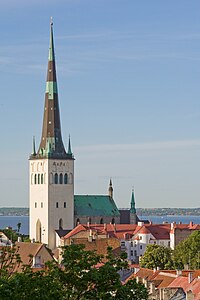

This article needs additional citations for verification. Please help improve this articlebyadding citations to reliable sources. Unsourced material may be challenged and removed.
Find sources: "St. Olaf's Church, Tallinn" – news · newspapers · books · scholar · JSTOR (May 2022) (Learn how and when to remove this message) |
| St. Olaf's church | |
|---|---|
Oleviste kirik
| |
 | |
 | |
| 59°26′29.1″N 24°44′52.1″E / 59.441417°N 24.747806°E / 59.441417; 24.747806 | |
| Location | Tallinn |
| Country | Estonia |
| Denomination | Baptist |
| Previous denomination | Roman Catholic, Lutheran |
| Website | Website of the Church |
| History | |
| Status | Active |
| Founded | 12th Century |
| Specifications | |
| Spire height | 124 metres (407 ft) |
St. Olaf’s ChurchorSt. Olav's Church (Estonian: Oleviste kirik) in Tallinn, Estonia, is believed to have been built in the 12th century and to have been the centre for old Tallinn's Scandinavian community before Denmark conquered Tallinn in 1219. Its dedication relates to King Olaf II of Norway (also known as Saint Olaf, 995–1030). The first known written records referring to the church date back to 1267. It was extensively rebuilt during the 14th century.
St. Olaf's Church was originally part of the united western tradition of Christianity, whose polity continues in the Roman Catholic Church today. However, during the Reformation the church became part of the Lutheran tradition. Eventually proving surplus to the requirements of the Evangelical Lutheran Church in Tallinn, St. Olaf's Church became a Baptist church in 1950.[1][2] The Baptist congregation continues to meet at St. Olaf's today.
From 1944 until 1991, the Soviet KGB used St. Olaf's Church's spire as a radio tower and surveillance point.[3]
There is a legend surrounding the construction of this building; The citizens of Tallinn wanted to build the tallest church in the world, but since there was a curse that ensured the death of anyone who finished its construction, no one was willing to do the work. Then a stranger appeared who asked for a large amount of money to do it. Since the city could not pay this sum, the foreigner proposed the following challenge: if they found out his name, he would forgive them the debt. For this, the Talinese sent a spy to his house who heard Olev's name in a song his wife sang. They waited for the foreigner to finish the construction and when he was putting the cross on the tower they shouted to him from below, Olev the cross is crooked, he got scared and fell to the ground with a toad and a snake coming out of his mouth, which denoted the demonic possession of this man. This fact is reflected in a mural painting on one of the sides of the church.
In 1590, the total height of the church tower was 115.35–125 m. The tower has been hit by lightning around 10 times, and the whole church has burned down three times throughout its known existence. After several rebuildings, its spire is now 123.8 meters tall.[4]
The organ was built between 1840 and 1842 by the german organist Friedrich Hermann Lütkemüller and installed by Johann Eberhard Walcker and three other assistants from the Walcker organ building company. From Lütkemüller's autobiography from 1869:
A renovation took place in 1914. The instrument has 76 Registers, 3 Manuals and a Pedal. The actions are pneumatic.
|
Churches in Tallinn
| |
|---|---|
| |
See also: List of churches in Estonia |
| International |
|
|---|---|
| Geographic |
|